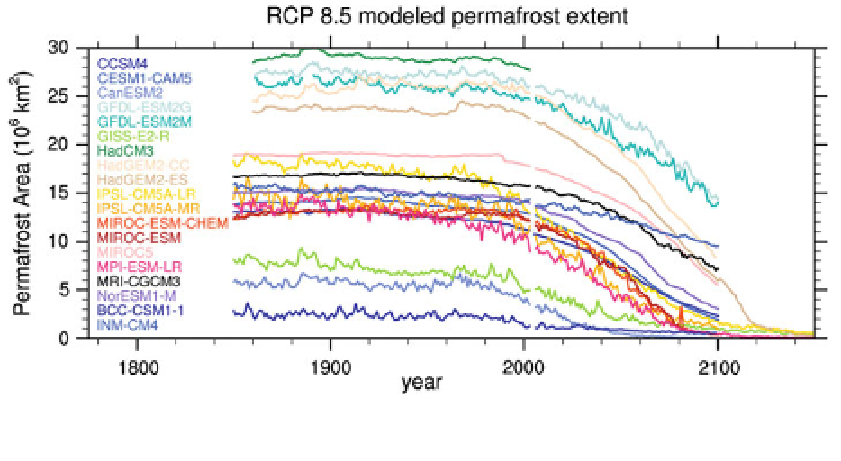Geoscience Reference
In-Depth Information
Fig. 8 Simulated total permafrost area for historical twentieth-century climate and future climate following
the RCP8.5 scenario for various CMIP5 models. Figure is taken from Koven et al. (
2012
)
temperature and soil moisture in climate modelling experiments. An inadequate initiali-
zation of these fields may lead to transient signals that have to be suppressed as much as
possible in modern numerical climate experiments as climate sensitivity experiments
operate with quite small signals.
3.3 Wetlands
Thawing permafrost will also contribute to the formation (French
2007
) or disappearance
(Smith et al.
2005
) of wetlands that currently cover about 6-8 % of the land surface. Note
that available global wetland observations span a range of potential wetland coverages,
partially due to their different wetland definitions which they are based on (see Stacke and
Hagemann
2012
). Despite this, they agree on many large-scale patterns that can be seen in
Fig.
9
showing the ensemble mean coverage of wetlands based on four different data sets.
Due to their function as water storage, the majority of research studies found that wetlands
regulate river discharge, mitigate flood events and show increased evapotranspiration
compared to other land cover types (Bullock and Acreman
2003
). However, some
exceptions to this general behaviour have been reported (van der Velde et al.
2013
) where
evapotranspiration is less efficient for wetlands than for other land cover types. The
extension of wetlands determines the area where anoxic decomposition instead of oxic
decomposition may take place. While CO
2
is released under oxic conditions, the anoxic
decomposition yields methane that is a far more active greenhouse gas than CO
2
. Here, the
water level is an important factor for the wetland's biogeochemistry which results in
carbon sequestration or decomposition (e.g., O'Connor et al.
2010
, and references therein).
Generally, an increase in wetland area will lead to an enhanced methane production. On
the other hand, a decrease will reduce moisture fluxes to the atmosphere and may lead to a
reduction in precipitation. Thus, their future development is of major interest in climate
change studies.
While most studies identify wetlands as net carbon sinks for today's climate conditions
(Bohn et al.
2007
; Gorham
1991
; Friborg et al.
2003
), a number of studies concluded that
some wetlands might turn into carbon sources in a warmer climate (St-Hilaire et al.
2010
;
Gorham
1991
) due to higher productivity of methane-releasing microbes. Several recent

